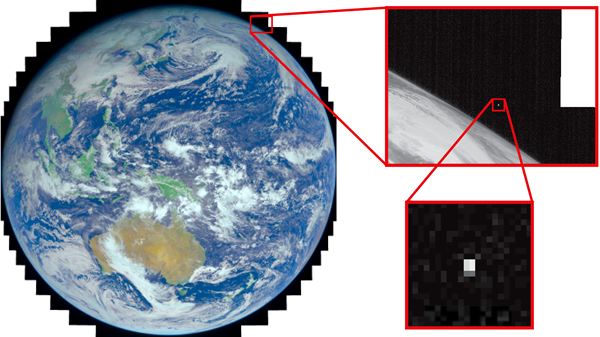When Betelgeuse mysteriously dimmed in late 2019 by over a magnitude, astronomers around the world rushed to turn their telescopes to the red giant star on Orion’s shoulder.
Little did they know that they were being joined by a Japanese weather satellite named Himawari-8.
From its geostationary orbit, Himawari-8 takes high-resolution images of Earth, capturing clouds, changes in vegetation — and occasionally, photobombing astronomical objects, appearing just off Earth’s limb. Inspired by a tweet of a Himawari-8 image that had serendipitously captured the Moon, two graduate students at the University of Tokyo, Daisuke Taniguchi and Shinsuke Uno, wondered if they could harness the weather satellite’s archives for astronomical research.
They found that Betelgeuse appeared in Himawari-8’s images roughly once every 1.72 days — including before, during, and after its enigmatic period of dimming from 2019 to 2020. What’s more, Himawari-8’s camera operates at mid-infrared wavelengths, where it can see temperature differences between clouds and the ground. That wavelength range is also good for observing astronomical dust, like the dust that shrouds young stars — or the dust that some astronomers think temporarily blocked Betelgeuse’s light and caused it to dim.
To help analyze Himawari-8’s data, Taniguchi and Uno recruited Kazuya Yamazaki, a graduate student in meteorology, and the trio published their results May 30 in Nature Astronomy. From the satellite’s data, they were able to estimate the amount of dust around Betelgeuse. They found that the dimming is most likely due to a combination of dust and also a cooling of the star’s temperature by about 250 degrees Fahrenheit (140 degrees Celsius). This is consistent with one of the most popular theories — that Betelgeuse expelled a hot clump of gas that condensed into dust when exposed to a cool region on the star’s surface.
The team think weather satellites have a lot of unrealized potential as astronomical telescopes. Mid-infrared radiation is blocked by Earth’s atmosphere, rendering it invisible to ground-based telescopes. There’s also a dearth of space-based observatories currently operating in the mid-IR. The Spitzer Space Telescope has been decommissioned since January 2020, and the SOFIA airborne observatory will also be shut down later this year. While the upcoming James Webb Space Telescope will be able to observe in the mid-IR, its time is so precious it won’t be able to look at one object repeatedly for years on end as weather satellites can.
Taniguchi says he and his colleagues have already begun other projects with Himawari-8 data, including making a catalog of tens of other giant stars and searching for transient infrared objects. “I hope some other astronomers in the world will start their own projects using Himawari-8 or other meteorological satellites,” he told Astronomy.










